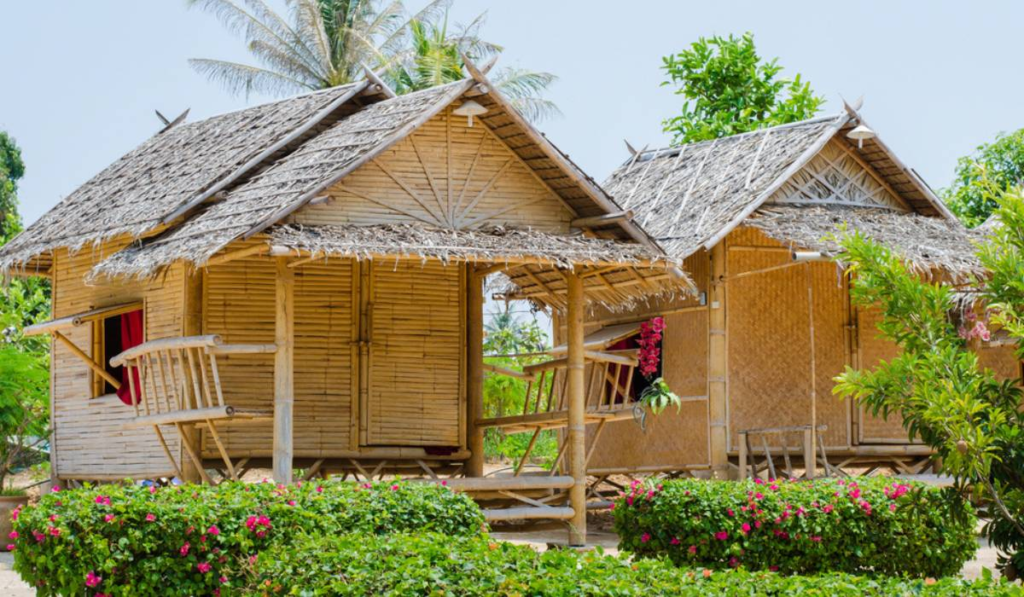India, with its rich cultural tapestry and diverse geography, boasts an impressive array of housing styles. From traditional dwellings that have stood the test of time to modern architectural marvels, the types of houses in India reflect the country’s history, climate variations, and evolving lifestyles.
This comprehensive guide explores 20 different types of houses found across the Indian subcontinent, offering insights into their unique characteristics and cultural significance.
Table of Contents
1. Kutcha Houses
Kutcha houses are basic dwellings commonly found in rural India. These houses are built using locally available materials such as mud, thatch, bamboo, and unburnt bricks.
While simple in construction, they are remarkably well-adapted to local climates. In hot regions, the thick mud walls provide natural insulation, keeping the interiors cool.
The use of organic materials also makes these houses eco-friendly and biodegradable. However, they require frequent maintenance and are vulnerable to extreme weather conditions.

2. Pucca Houses
Pucca houses represent a significant upgrade from kutcha houses in terms of durability and comfort. These permanent structures are built with materials like burnt bricks, cement, concrete, and steel.
Pucca houses are more resistant to weather conditions and natural disasters, making them a preferred choice in both rural and urban areas. The transition from kutcha to pucca houses is often seen as a sign of economic progress in rural communities.
Many government housing schemes in India focus on providing pucca houses to low-income families to improve their living conditions.
3. Havelis
Havelis are grand mansions found primarily in North India, particularly in Rajasthan and Gujarat. These ornate houses are a testament to the opulent lifestyle of wealthy merchants and nobility of bygone eras.
Havelis feature intricate carvings, multiple courtyards (aangan), and elaborate frescoes. The architecture of havelis is designed to provide comfort in harsh climates, with thick walls for insulation and jharokhas (overhanging enclosed balconies) for ventilation.
Many havelis have been converted into heritage hotels or museums, preserving this unique architectural style for future generations.

4. Bungalows
Bungalows, introduced during the British colonial era, have become an integral part of Indian residential architecture. These single-story houses typically feature wide verandahs, sloping roofs, and spacious interiors.
The term “bungalow” is derived from the Hindi word “bangla,” meaning “Bengali style house.” Originally designed for British officials, bungalows were adapted by Indians and became synonymous with middle and upper-middle-class housing.
Modern bungalows often incorporate elements of traditional Indian architecture, creating a unique fusion style that blends colonial and indigenous design elements.
5. Apartments
Apartments or flats are the backbone of urban housing in India. These multi-story buildings offer various configurations (1BHK, 2BHK, 3BHK) to suit different family sizes and budgets.
The rapid urbanization of India has led to a boom in apartment construction, transforming the skylines of major cities. Modern apartment complexes often include amenities like gyms, swimming pools, and community halls, catering to the lifestyle needs of urban dwellers. Recent trends in apartment design include the incorporation of green spaces, such as rooftop gardens and vertical forests, to combat urban pollution and provide residents with a connection to nature.

6. Villas
Villas represent the epitome of luxury housing in modern India. These standalone houses offer privacy, space, and often come with premium amenities.
Typically found in gated communities or exclusive neighborhoods, villas cater to affluent buyers seeking a high-end living experience. Many villa projects in India now incorporate sustainable design principles, such as rainwater harvesting and solar power generation.
Some luxury villa communities also offer personalized services like concierge and housekeeping, providing a resort-like living experience.
7. Row Houses
Row houses, also known as townhouses, offer a balance between the privacy of independent houses and the community aspect of apartment living. These narrow, multi-story homes share side walls with adjacent houses but have independent entrances and often small front and back yards.
Row houses are an efficient use of land in urban and suburban areas, making them increasingly popular in many Indian cities. They are particularly attractive to young families who desire outdoor space but may not be able to afford a full-fledged villa or bungalow.

8. Houseboats
Houseboats, found primarily in Kashmir and Kerala, offer a unique living experience that blends traditional craftsmanship with modern comfort. In Kashmir, houseboats on Dal Lake and Nageen Lake, known as “shikaras,” feature ornate woodwork and plush interiors. Kerala’s houseboats, called “kettuvallams,” were traditionally used for transporting goods but have been repurposed as floating hotels. These houseboats play a crucial role in the tourism industry of both regions, offering visitors a chance to experience life on the water while enjoying stunning natural surroundings.
9. Tree Houses
Tree houses, traditionally found in some tribal areas of India, have gained popularity as eco-friendly retreats and vacation homes. These elevated structures offer a close connection with nature while providing modern comforts.
In states like Kerala and Karnataka, luxury tree house resorts have become popular tourist attractions, offering a unique blend of adventure and comfort. Some eco-conscious architects are also exploring tree house designs for permanent residences, creating sustainable homes that literally bring inhabitants closer to nature.

10. Eco-Friendly Houses
As environmental awareness grows, eco-friendly houses are becoming increasingly popular in India. These sustainable homes incorporate green technologies and design principles to minimize their environmental impact. Features may include solar panels, rainwater harvesting systems, energy-efficient appliances, and the use of sustainable building materials. Many eco-friendly houses in India blend traditional architectural wisdom, such as the use of courtyards for natural ventilation, with modern sustainable technologies. Government initiatives and green building certifications are encouraging the adoption of eco-friendly housing practices across the country.
11. Smart Homes
Smart homes represent the cutting edge of residential technology in India. These tech-driven houses integrate advanced systems for automation, security, and energy efficiency. Features often include IoT devices, automated lighting and climate control, voice-activated assistants, and remote monitoring capabilities.
As India’s tech-savvy population grows, the demand for smart home features is increasing, particularly in major cities and IT hubs. Many developers are now incorporating smart home technologies as standard features in new residential projects.

12. Co-Living Spaces
Co-living is an emerging trend in Indian cities, especially popular among young professionals and students. These shared living spaces offer fully furnished private bedrooms with common areas for socializing and working. Co-living addresses the challenges of urban housing shortages and high rental costs while catering to the social needs of young city dwellers.
Many co-living startups in India are transforming existing buildings into modern, community-oriented living spaces, adding a new dimension to urban housing options.
13. Micro-Apartments
As land prices in Indian cities continue to rise, micro-apartments are emerging as a solution for affordable urban living. These compact living spaces, typically under 500 square feet, are designed to maximize functionality in a minimal footprint.
Micro-apartments often feature clever storage solutions and multifunctional furniture to make the most of limited space. They are particularly attractive to single professionals and couples who prioritize location over space, especially in cities with long commute times.

14. Farmhouses
Farmhouses serve as rural retreats, often used as second homes or weekend getaways for urban dwellers. These spacious properties feature large plots of land, allowing for agriculture or gardening alongside comfortable living spaces.
In recent years, the concept of farmhouse living has evolved, with many properties offering luxury amenities and serving as venues for events and weddings. Some eco-conscious individuals are also turning to farmhouse living as a way to pursue sustainable, self-sufficient lifestyles.
15. Penthouses
Penthouses are luxury apartments located on the top floors of high-rise buildings, offering expansive views and premium amenities. These exclusive residences often feature high ceilings, large windows, and private terraces or rooftop gardens.
Penthouses are particularly popular in major metropolitan areas, catering to high-net-worth individuals seeking the ultimate in urban luxury living. Many modern penthouses in India incorporate smart home technologies and sustainable features, combining luxury with eco-consciousness.

16. Studio Apartments
Studio apartments are compact living spaces that combine the bedroom, living area, and kitchenette into a single open-plan room. Popular among students and young professionals in urban areas, studios offer an affordable entry point into the housing market.
The design of studio apartments often incorporates clever storage solutions and multifunctional furniture to maximize the use of limited space. In recent years, there’s been a trend towards high-end studio apartments in premium locations, catering to young, affluent professionals.
17. Chawls
Chawls are a type of tenement housing found primarily in Mumbai, consisting of single-room accommodations with shared toilets and bathrooms. Originally built in the early 20th century to house mill workers, chawls represent a unique aspect of Mumbai’s housing history and working-class culture.
While many chawls are being redeveloped into modern apartments, some are being preserved as heritage structures, recognizing their cultural and historical significance.

18. Palaces
While not common residences, palaces are an important part of India’s architectural heritage. These grand structures, once home to royalty, now often serve as museums, heritage hotels, or tourist attractions.
Palaces like the City Palace in Jaipur or the Mysore Palace showcase the opulence and architectural mastery of India’s royal past. Some royal families still reside in parts of these palaces, maintaining the legacy of India’s princely states.
19. Bamboo Houses
Common in Northeast India, bamboo houses are eco-friendly structures that utilize locally available bamboo. These houses are well-suited to the region’s climate, offering natural cooling and excellent earthquake resistance.
The use of bamboo in construction is gaining popularity beyond the Northeast, with architects exploring its potential for sustainable housing solutions across India. Modern bamboo houses often combine traditional building techniques with contemporary design, creating stylish and environmentally friendly homes.

20. Container Homes
A recent trend in alternative housing, container homes repurpose shipping containers into living spaces. These modular homes offer a unique aesthetic and are appreciated for their sustainability and affordability. Container homes can be quickly assembled and are easily transportable, making them an attractive option for temporary housing or in areas where traditional construction is challenging. While still a niche market in India, container homes are gaining interest among eco-conscious homeowners and as solutions for low-cost housing projects.
-
What are the five different types of houses in India?
Five common types of houses in India are apartments, villas, bungalows, kutcha houses, and havelis.
-
What materials are commonly used in constructing houses in India?
Common materials used in Indian house construction include bricks, concrete, wood, steel, and locally sourced materials like mud and bamboo for traditional houses.
-
What are the most common types of houses in urban India?
The most common types of houses in urban India are apartments, builder floors, and row houses.
-
What is the difference between a villa and a penthouse in India?
A villa is a standalone house with its own plot of land, while a penthouse is a luxurious apartment on the top floor of a high-rise building.
-
What is the main feature of a villa in India?
The main feature of a villa in India is its standalone structure with private outdoor space, often located in gated communities with luxury amenities.
Conclusion
The diverse types of houses in India reflect the country’s rich cultural heritage, geographical diversity, and evolving societal needs. From traditional kutcha houses to modern smart homes, each type of dwelling tells a unique story of adaptation and innovation. As India continues to urbanize and modernize, new housing trends emerge while traditional styles are being reinvented to meet contemporary needs.
This variety in housing not only showcases India’s architectural ingenuity but also highlights the country’s ability to blend tradition with modernity. Whether it’s the grand havelis of Rajasthan, the houseboats of Kerala, or the high-rise apartments of Mumbai, each type of house contributes to the rich tapestry of Indian residential architecture.
We’d love to hear about your experiences with different types of houses in India. Have you lived in or visited any of the house types mentioned in this article? Do you have a favorite style of Indian housing? Share your thoughts and stories in the comments below!
